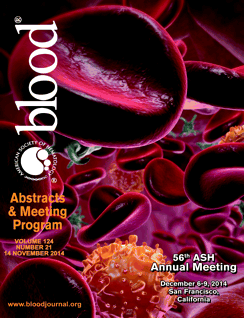Abstract

Introduction
Hematopoiesis is maintained in close contact with bone marrow (BM) stroma. Malignant hematopoietic cells probably affect the hematopoietic microenvironment, as well as high dose chemotherapy.
The goal of this study was to analyze the alterations in the characteristics of human multipotent mesenchymal stromal cells (MSC) and their more differentiated progeny – fibroblastic colony forming units (CFU-F), derived from the BM of acute myeloid and lymphoid leukemia (AML and ALL) patients.
Methods
26 newly diagnosed cases (18 AML, 8 ALL) and 35 patients (20 AML, 15 ALL) before and during 1 year after allogeneic hematopoietic stem cell transplantation (alloHSCT) were involved in the study after informed consent. BM was aspirated prior to any treatment in the newly diagnosed group and before the conditioning and at 6 time points during 1st year after the alloHSCT. MSC were cultured in aMEM with 10% FCS. Cumulative MSC production was counted after 3 passages. CFU-F concentration was analyzed in BM samples by standard protocol. The relative expression level (REL) of genes was measured by RT2 Profiler PCR Array (Qiagen) and TaqMan RQ-PCR. MSC and CFU-F from 50 healthy donors of BM for alloHSCT were used as a control after informed consent.
Results
The CFU-F concentration in the BM of patients at the moment of diagnostics was 1/3 of the donor’s for AML and ≈1/10 of ALL (9±5.2 and 3.9±2.3 versus 31±3.5 per 106 nucleated cells in donor BM, p<0.05). Most of the patients assigned to alloHSCT were in the remission and at that moment CFU-F concentration in their BM differed insignificantly from the donors’ one. After alloHSCT CFU-F concentration in AML and ALL patients’ BM decreased 3-9 folds for the whole next year. The decrease at each time point was highly significant comparing to donors. MSC properties were also altered in patients with acute leukemia. Cumulative cell production in MSC of newly diagnosed AML and ALL patients did not differ from donors’ one. MSC production from the BM of patients after standard courses of chemotherapy (for AML patients -mainly various numbers of “7+3” blocks and for ALL patients - ALL-2009) before alloHSCT did not differ from donors, while after alloHSCT cumulative AML and ALL MSC production decreased 1.3-6.3 folds for the next year. The decrease at almost each time point was significant comparing to donors. Gene expression analysis revealed that in MSC at the moment of AML diagnosis the REL of FGF2, IL1B, IL6, JAG1, PDGFB, VCAM1, VEGFA decreased more than 2 fold. Prior to alloHSCT the REL of IL6 and IL1B were still very low, after the alloHSCT the REL of IL6, JAG1, PDGFB increased, while IL1B stayed at the low level at least for 6 months. In MSC at the moment of ALL diagnosis the REL of IFNG, IGF1, IL6, KITLG, NES, PTPRC, TBX5 decreased more than 5 fold, while these of CSF3, ICAM1, IL1B, ITGAX – increased more than 5 fold. REL of IL6 and IDO1 were elevated prior to alloHSTC and stayed at such level for a year. Prior to alloHSCT the REL of FGFR2, PDGFRA, SDF1 and FGF2 were very low, after the alloHSCT the REL of JAG1, FGF2, TGFB1 slightly increased, while FGFR2, PDGFRB, SDF1 stayed at the low level at least for 1 year.
Conclusions
During the leukemia development malignant cells alter the stromal precursor cells leading to the decrease in the REL of many regulatory genes and in the number of more differentiated stromal precursor cells in the BM. Chemotherapy used for induction of the remission in these patients restore functional ability of MSC and CFU-F, while gene expression levels remained altered. Conditioning regiments used for the alloHSCT significantly damage both types of studied stromal precursors, and the effect lasted at least for 1 year. So, both leukemic cells and chemotherapy affect BM hematopoietic microenvironment.
No relevant conflicts of interest to declare.
Author notes
Asterisk with author names denotes non-ASH members.

This icon denotes a clinically relevant abstract

